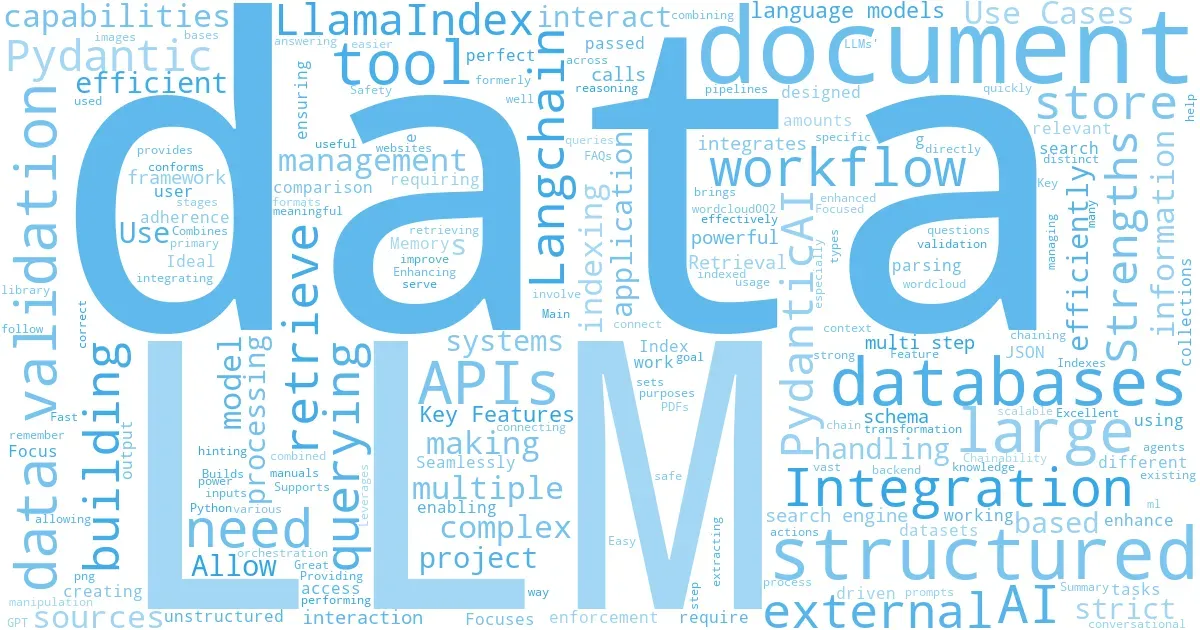PydanticAI vs. Langchain vs LlamaIndex

PydanticAI, Langchain, and LlamaIndex are all frameworks/tools that interact with large language models (LLMs) but serve distinct purposes. Here’s a comparison of their key features, strengths, and use cases:
1. PydanticAI¶
PydanticAI is a Python library that enhances the usage of Pydantic models with AI capabilities. It brings AI-enhanced data validation and manipulation capabilities to the Pydantic framework, making it more efficient when integrating with language models and structured data.
Key Features:¶
- Data Validation: Leverages Pydantic's powerful data validation capabilities, ensuring that data passed through models is correct and structured.
- Type Safety: Builds on Pydantic’s type hinting, making your models type-safe while using AI-driven validations.
- Integration with LLMs: It can be used to improve the interaction between LLMs and structured data (like JSON or databases), ensuring that the data passed to the model conforms to specific schemas.
Strengths:¶
- Schema-based Data Management: Ideal for projects that need strict data validation and type enforcement.
- Combines AI and Structured Data: Focuses on combining the power of structured data with AI, making it useful when working with APIs, databases, or structured inputs and outputs.
Use Cases:¶
- AI-driven data validation and transformation tasks.
- Projects where you need strict adherence to data formats (e.g., working with structured datasets like JSON).
- Enhancing Pydantic’s existing capabilities for managing structured input-output with LLMs.
2. Langchain¶
Langchain is a framework designed for building applications with language models (LLMs). It provides tools for creating complex LLM workflows, handling documents, and chaining multiple steps to process data efficiently.
Key Features:¶
- Chainability: Allows users to chain multiple prompts and LLM calls in complex workflows.
- Memory: Supports memory management, where LLMs can remember context across different calls and interactions.
- Document Handling: Allows parsing and querying documents, such as PDFs, websites, or databases, directly through LLMs.
- APIs and Tools Integration: Langchain integrates with many APIs and tools to enhance LLMs' capabilities, like connecting to databases, search engines, and external data sources.
Strengths:¶
- Powerful Workflow Management: Great for building complex pipelines that involve multiple stages of data processing and multiple model calls.
- Easy Integration: Seamlessly integrates with external tools and APIs, making it perfect for applications that need to connect to various data sources.
- Document Processing: Excellent for handling and querying large sets of documents.
Use Cases:¶
- Building conversational agents or systems that require multi-step reasoning or follow-up actions.
- Querying large documents and extracting relevant information using language models.
- Creating workflows where LLMs interact with APIs and external systems, such as databases and search engines.
3. LlamaIndex (formerly GPT Index)¶
LlamaIndex is designed to help LLMs interact with external data sources more effectively. It focuses on indexing large datasets and allowing LLMs to efficiently retrieve information from those sources.
Key Features:¶
- Data Indexing: Indexes structured and unstructured data, making it easier for LLMs to retrieve and interact with information in a meaningful way.
- Querying and Retrieval: Allows LLMs to retrieve relevant information from the index, answering questions or performing tasks based on indexed data.
- Document Store Integration: Integrates with multiple document stores and databases to allow LLMs to access large amounts of data.
Strengths:¶
- Efficient Data Retrieval: Focused on indexing and quickly retrieving data, enabling LLMs to work efficiently with large amounts of unstructured or structured data.
- Data Integration: Works well with different data stores, such as databases, document stores, and APIs, enabling LLMs to access vast data sources seamlessly.
Use Cases:¶
- Building systems that require efficient querying of large document collections or databases (e.g., FAQs, manuals, knowledge bases).
- Providing a backend search engine for LLMs where they can retrieve data based on user queries.
Comparison Summary¶
| Feature/Tool | PydanticAI | Langchain | LlamaIndex |
|---|---|---|---|
| Main Focus | Structured data validation + LLMs | Workflow orchestration for LLMs | Efficient data indexing + retrieval |
| Key Strengths | Data validation, type enforcement | Workflow management, document handling | Fast and scalable data indexing & search |
| Ideal Use Cases | Projects requiring strict data types | Complex LLM workflows, multi-step processing | Querying large data or documents |
| Integration Focus | AI + Structured data | APIs, external tools, and document parsing | Document stores, databases, and APIs |
When to Use Which?¶
- Use PydanticAI if you need strong data validation and structured data management combined with LLMs, especially in applications requiring strict schema adherence.
- Use Langchain if you're building a more complex application that needs multi-step interactions with LLMs, document processing, and integration with external tools like databases or APIs.
- Use LlamaIndex if your primary goal is to enable LLMs to efficiently retrieve data from large document collections, databases, or other data stores. It’s perfect for building query-based systems that need to search and retrieve information.
Each of these tools is a powerful choice depending on the needs of your project!
Last updated 2024-12-16 00:41:44.268810 IST
Comments